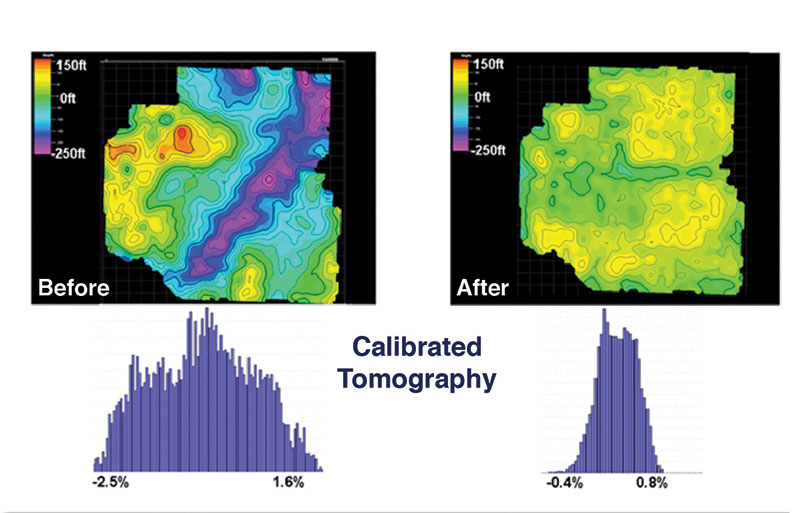3-D seismic data are being viewed as the way to reduce drilling cost overruns and maximize ultimate recovery from a shale-producing field – and for relatively minimal additional cost.

Results of a reservoir level seismic surface depth tie to the available well control. The purple trench (upper left) is associated with near-surface velocity variations modeled using three-term tomography. The tightening of the well tie histogram (lower right) provides more confidence in the depth of the interpreted surface after advanced imaging.
Once upon a time, a shale zone was looked on as a source rock for hydrocarbons or as a seal to prevent oil and gas below the zone from moving upward and escaping into other formations.
It was only several years ago that the shale world’s hydrocarbon treasure was targeted directly by the drill bit.
These seemingly ordinary, organic-rich tight rocks were recognized as actual reservoirs and quickly became major go-to drilling objectives, triggering a whole new era in the petroleum industry.
It’s all been possible technically and economically because of horizontal drilling and hydraulic fracturing – multi-stage fracturing for the most part.
But if you tend to think a shale is a shale, think again.
“Some geological assumptions early on were that shale in a reservoir unit is pretty much homogeneous,” said Greg Johnson, principal area geophysicist at WesternGeco in Denver. “If you drill evenly and fracture evenly, it will produce, and we’ll extract the maximum resource.
“Since then, it’s been recognized that there’s variability in production even between adjacent horizontals,” he said. “The challenge becomes the design of the infill drilling program and how best to maximize the ultimate recovery of resource from each field in a timely fashion.”
Enter 3-D seismic data.
‘Something Meaningful’
It likely comes as no surprise that 3-D data are being viewed as the way to reduce drilling cost overruns and maximize ultimate recovery from a shale-producing field – and for relatively minimal additional cost.
Johnson emphasized the key is processing the seismic data specifically for these types of plays without taking shortcuts owing to perceived time and cost constraints.
“I’m on the surface seismic side of things,” he noted. “We can cover a large land position with our seismic data as opposed to borehole data, which is just at the borehole and then extrapolated between measurement points.
“The challenge is to couple those two sets of data together into something meaningful, and that’s what our work does,” Johnson said. “It’s an integrated workflow that pulls all that technology together and tries to describe the heterogeneity we’re seeing in the production side.
“Land 3-D seismic data are normally acquired with multiple azimuth directions between source and receiver positions,” Johnson noted. “Multi-azimuth seismic data enable superior imaging, and if the azimuthal information is carried correctly through all imaging steps, multi-azimuth inversion techniques utilizing both residual travel times and amplitudes can be effectively used for reservoir property description.”
The data are migrated in offset vector tile (OVT) format, which affords a way to sort the input data in a manner such that when multi-azimuth information in the seismic data is referenced, it refers to direction and azimuth between a source and receiver when the data are recorded.
Once the geoscientists lay out the surface pattern of the source and receivers, the azimuth of those vectors is a critical information component in the data.
Johnson noted that in the past this information was lost when the data were migrated. Everything got mixed together in the final image.
OVT enables preservation of the azimuthal source-receiver information through the migration, meaning it can be analyzed post-migration.
“The tomography process performed following migration works better when we preserve the multi-azimuth information in the data,” Johnson emphasized. “Tomography allows us to update the velocity model in much more detail than without it.”
Getting Real
In the past, 3-D surface seismic data were recorded in time. The source was fired, and the noise was picked up and recorded in time.
“Traditionally, processing has stayed in the time listening domain called two-way time, or the time for the energy to go down, hit the reflector and come back up,” Johnson said. “We’re working to produce an image or cross section of the earth that is not in time but actual depth – drillers work in the real earth.
“Now, when we migrate the seismic, we actually transform it from two-way time to depth on output, collectively called depth migration,” he noted. “This advanced imaging becomes even more advanced when you can go from time to depth, and at the same time you’re doing that you actually calibrate to known depths of the wells.
“Performing that all in one step makes the migration more accurate in terms of the information it carries through,” Johnson added.
Needed: Integrated Effort
It’s essential to recognize the unconventional puzzle, e.g. variability in productivity rates, cannot be solved without all hands on board.
“It has to be an integrated multi-disciplinary effort of geologists, geophysicists, petrophysicists,” Johnson emphasized. “All of the different data measurements that are made have to all come together on these projects; that’s the goal here.
“We’re bringing in the data from the wells right up front in the work we do,” he said. “Our version of advanced imaging achieves high image fidelity (flat gathers) and optimal seismic-to-formation ties by means of the imaging step, requiring little if any post-imaging calibration.
“Inversion processes can then be done with greater confidence in the accuracy of the results.”